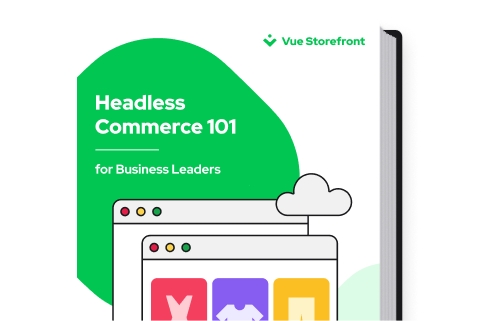Explore by Category:
Headless Commerce
Best Headless Commerce Platforms in 2024
In early 2023, we rolled up our sleeves and decided to get straight to the point. Which is? To help businesses sort out and clarify the confusion that has arisen around headless topics.
In this piece, you will find some of the examples of the best headless commerce platforms. You will get some hints at critical aspects, like what to look for in the so-called best headless commerce platforms? What to know and what to consider before choosing a headless platform in 2023? And of course, we provide some examples of good headless solutions for consideration when shifting towards headless commerce .
What is a Headless Platform in eCommerce?
A headless platform is a software that fits into the headless commerce approach. It’s a modern, efficient software working as a decoupled system. The architecture of a headless platform separates the presentation layer from the commerce engine, hence the communication between instances of the platform is swift. Headless platforms use APIs for data orchestration and as a result, each implementation proceeds faster and the whole system runs more responsively.
Headless industry evolves, so do Headless Platforms
And it's happening fast, even ultra-fast. So it's no wonder there's a lot of buzz around headless, and the word itself is overused. Following the statement, we can point out that headless commerce became a response to the market challenges and burdens monolith eCommerce platforms caused, such as:
- delivery time
- high risk of failure when applying even a small change
- high dependence
- tedious, repetitive work
- scaling
- performance
The immediate need for efficient development and deployment lead to a change in the eCommerce approach on the tech side. And this point is often overlooked. Best headless commerce platforms are designed to drive the tech implementations for business benefits. Additionally, headless platforms provide flexibility on the technical side. Since the approach influences the development, the business strategy gets a tangible boost.
Best Headless Commerce Platforms align business and tech
In a better way. Customers quickly got used to consuming the content via multiple touchpoints. Over the decade ago we were aligned with the web view. However, since mobile (r)evolution, a lot has changed. The web page is not the only marketplace to sell, omnichannel took over, and the old way of executing online business became a tedious activity for both developers and marketers.
That’s one of the reasons why headless commerce became a sweet and quick getaway from the burdens caused by coupled systems. With the growing popularity of headless solutions, many platforms occurred and numerous vendors supply diverse headless features. There are already on the market providers of headless CMSs , headless commerce platforms, and headless storefronts. And they vary from being open-source to vendor locked-in. Some are still monoliths with headless gateway features, some provide pure headless experience.
No wonder when one starts to look for some legitimate information, it becomes hard to separate the truth from the fancy. So, with the basic question – how to choose the best headless commerce platform in mind – we have prepared some hints on what to do before betting on “the one”. To ease (at least a bit) the decision, we highlight some of the best headless commerce platforms for various market sizes.
How to choose the best Headless Commerce Platform?
As it usually happens, the answer can be short: it depends, or more comprehensive. Making a big decision takes a lot of research, consideration, and hours spent on consulting since each case is individual. Below you will find the steps you should take before choosing the best headless commerce platform for your business.
- Have a talk - business and tech together
The initial phase of considering re-platforming or choosing that one best headless commerce platform should be a talk. The business side and the tech side should gather together to discuss the needs they have.
Companies make a mistake by excluding one or another part at this stage of going headless. It’s important to learn to listen to the requirements each side demonstrates. This will save tons of time and will help shape a clearer view of what the enterprise needs on the tech and the business side. And it is not about understanding each party 100%. This is rather impossible.
The objective is to sort out the issues each partaker would like to overcome. Also, this will help understand dependencies, draw the workflow, and help obtain consensus faster. This will not only help better determine the best headless commerce platform for a particular case but also will ease the digital headless transition.
- Determine the stage of digital maturity
In other words, don't sink into your ambitions. Keep in mind that your goals should be realistic and feasible. To address business and technical needs accurately, it’s a good idea to determine the stage of digital maturity of your business.
Which is? In simplified understanding, it’s the business’s ability to quickly respond to or take advantage of opportunities in the market based on current tech stacks, human resources, and technology. It is the command of an organization to embrace digital transformation beyond the digital. It's a process of a complex and accurate understanding of the entire organization, including employees, working environment, and organizational policies to drive business results smartly.
Although it all might sound a bit overwhelming, in the case of determining the digital maturity of an eCommerce, the process can be executed internally. Here we present the high-level definition of specifying digital maturity, which applies to the digital transformation of any organization and industry. Due to the eCommerce online nature, it does not require a huge undertaking. It is more of a strategy adjustment and streamlining operations on a relatively quick basis.
Still, why is it worth spending some time clarifying digital maturity? To exclude high-cost and low-value decisions. Choosing the best headless commerce platform is a decision-making process binding for years. Hence it is worth spending some time at the beginning of reexamining the business strategy to better shape further operations. The more carefully throughout the environment is, the better chances are at avoiding initiatives that the technology won’t support.
There are several frameworks on the market provided by consulting companies. You can support your initiative with ready-made tips and hints. Nevertheless, in the case of choosing the best headless commerce platform (and going headless in general), it all comes down to which IT solution provider will best match your organizational needs.
- Outline the objectives
Having determined the requirements on the technical and business side, as well as the very own stage of digital maturity, now is the time to set the objectives. Going through the first two stages of the process of choosing the best headless commerce platform will help set realistic goals for further growth.
It is vital to confront the business ambitions and tech capabilities again and clarify the upcoming changes. Having your specific needs sorted and listed will help with the next step - searching and researching. There is already a broad pool of headless commerce solutions; it is important to keep in check.
- Do your own research
After the talking and outlining parts, comes the next step, getting you closer to finding the best headless commerce platform. You may already have your selections. List them out, try to match them with your requirements, and then discuss them with the other parties involved in the process. Be in line at each stage of your search for the best headless commerce platform. It never is a one-person decision. Keep in mind that the software you choose will be responsible for driving revenue and shaping your workflow for the next (probably) a couple of years.
- And have a talk, again
This time with possible vendors. The one true partner will not try to rush you with a decision. Instead, they will provide you with comprehensive information. Before the big conversation, suggest inviting business and IT representatives to the table. The sale of any software, especially one that is expected to drive your revenue, needs to be accompanied by the right recommendation. It should be about matching your tech stack with your goals, capabilities, and further support.
Best Headless Commerce Platforms for 2023
And beyond. Choosing the best headless commerce platform is not an easy task. It is a multi-step process that requires some collaboration and strategic (or at least tactic) thinking. It demands a realistic view of the market position and an assessment of opportunities. Knowing that will help choose the best headless commerce platform that will drive the ROI in 2023 and beyond.
Below are some of our recommendations of the best headless commerce platforms in relation to the stage in which your eCommerce business is currently. We have listed the best headless commerce platforms fulfilling the needs of the lower digital maturity with out-of-the-box solutions, up to the higher with build and customization options.
- Shopify
- Salesforce Commerce Cloud
- Magento 2
- Fabric
- Vendure
- SAP Commerce Cloud
- Spryker
- Elastic Path
- BigCommerce
- commercetools
Headless Shopify
One of the most globally recognized eCommerce platforms can now fit into a headless approach. Shopify enabled smooth headless transition with its GraphQL and REST APIs. The core stability and functioning stay with the merchant while the storefront may become open to further customization .
Shopify is best suited to small to medium size eCommerce businesses.
Salesforce Commerce Cloud
Salesforce Commerce Cloud power can be confirmed by numerous B2B and B2C brands that trusted the enterprise solution. SCC is a cloud-based software-as-a-service (SaaS) commerce platform to create smart, unified buying experiences across mobile, social, web, and store.
SCC is targeted at brands and retailers that require B2C functionality that want to focus on trading, not development.
Magento 2
You can choose Magento 2 Open Source, Magento 2 Commerce, or Magento 2 Commerce Cloud. Each solution is designed to cover the extensive needs of eCommerce owners. Commerce and Commerce Cloud are designed with B2B and larger enterprises needs in mind, to handle high customer traffic, large product catalogs, broad global presence, or high business complexity. Combined with the headless storefront, Magento 2 provides great frontend performance and UX for high-traffic enterprise eCommerce players.
Magento 2 extension development or API modification typically requires specialist Magento developers.
Fabric
The Seattle-based startup offers a headless commerce platform purpose-built for growth. It provides back-end infrastructure for online shopping. Fabric’s open and modular design allows B2B and direct-to-consumer companies to be live in weeks, replacing expensive, complex legacy platforms that hold back performance and growth.
Beyond being a Product Information Management & Order Management System, Fabric offers membership & offer management, subscriptions and marketplace integrations.
Vendure
A dark horse that soon may become the next headless unicorn. Vendure can be described as an alternative for those that have outgrown Shopify, offers modern headless GraphQL framework that runs eCommerce. Easy to set up and to navigate with its captivating and intuitive admin interface. Vendure connects with storefronts available for Next and Vue.
Vendure is open-source, built on Node.js, TypeScript and GraphQL. They don’t offer a frontend - they focus purely on their API framework.
SAP Commerce Cloud
SAP Commerce Cloud is a commerce solution built primarily for large enterprises with advanced B2B, B2C, and B2B2C use cases. SAP’s solution offers an omnichannel, responsive storefront with other commerce modules created for both B2B and B2C users. Rich in sophisticated options offers a centralized content repository and high-end features for shaping a personalized shopping experience.
Being an enterprise SaaS, SAP controls the product roadmap which may be beneficial for larger businesses.
Spryker
Berlin-based headless vendor provides a modern platform-as-a-service solution with over 900 API-based modules, cloud-enabled, enterprise-ready, and loved by developers and business users. Spryker offers a shop system for fully digitizing and scaling eCommerce.
Spryker’s fully composable platform has the tools to help you launch B2B platforms, marketplaces or subscriptions.
Elastic Path
Complex, API-driven solution matching the fundamental eCommerce business requirements. Elastic Path provides strong customer and support service, hence, becomes a considerable option for eCommerce. The headless architecture enables the creation of internal and operational efficiencies and improves business process agility.
BigCommerce
Plenty of tools, rich app ecosystem on a single open-source platform. BigCommerce offers enterprise-grade functionality with a user-friendly interface and very responsive customer support. It aims to help merchants sell more at every stage of business growth. The solution supports compliance and risk management, as well as drives innovation in a headless way.
commercetools
This innovative solution can be described as the world’s leading platform for next-generation B2C headless commerce and B2B headless commerce . And there's no exaggeration. Commercetools offers a pure headless experience with over 300 API endpoints. This multi-tenant SaaS commerce and cloud-native platform provides the commerce layer and partners with top headless solutions to lead the market.
Now you know your best headless commerce platform, what's next?
When the decision is made, it is a good idea to think once again. This time about the range of possibilities you’ve opened up. And what you can do to provide even greater opportunities. Headless commerce provides great flexibility to the business and the technical side.
Best headless commerce platforms, even when not 100% flawless, deliver composable resolutions. Many headless solutions providers partner with multiple vendors to assure a composable stack. You can choose the perfect storefront to even better shape the experiences, add a headless CMS to smartly deliver content, and enjoy enhanced capabilities, that drive revenue. After all, headless commerce is all about fractioning and playing with composable 3rd party applications. Freedom of choice among dev tools and flexibility at the front is one of the decisive factors playing in favor of headless.
Share:
Share:
More in Headless Commerce
Ready to dive in? Schedule a demo
Get a live, personalised demo with one of our awesome product specialists.






















